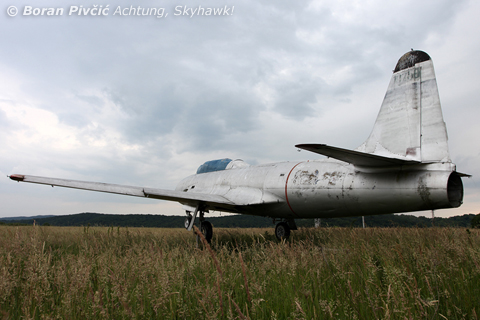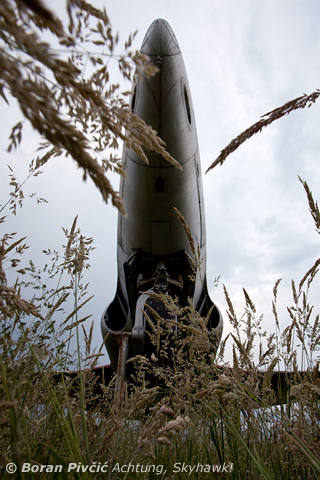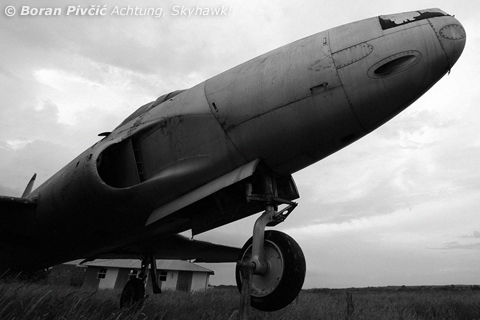By me
All photos me too, copyrighted
After a couple of years of driving ’round the various back roads that wind across the countries of former Yugoslavia, you get used really to seeing the oddest things by the side of the road… an old tank here, some deserted barracks there – and everything else up to the occasional motionless radar dish and overgrown abandoned bunker. Certainly, I myself have seen quite a few of these on my travels, and almost thought myself beyond surprise anymore – until, while rounding the crest of a small hill in central Croatia, I suddenly saw a silver T-33 Shooting Star rising up from the tall, unkempt farmland grass :D.
My surprise was not lessened even by the fact that I was actually looking for this specific aircraft – nor that I’d already been here several years ago, and had flown over this spot at low altitude more than a dozen times :). But, that first instant of seeing an abandoned aircraft, a piece of history, so much out of its element, is always a thrill – so much so that I was forced to apply liberal amounts of braking to avoid spearing off into the undergrowth :D.
The location for this near-off was Čazma airfield (LDZC), an unassuming little strip located about an hour’s drive east of Zagreb. Overgrown and uncared for, Čazma had been established in 1944 as a supply airfield by the Yugoslav Partisans, and had after the war gone on to serve as a base for agricultural aircraft (surrounded, as it is, by the abundant farmland characteristic of this part of Croatia). Following the decline of cropspraying flights some years ago, Čazma had progressively become disused and forgotten, until it had even dropped off the aeronautical maps about a year ago (for reasons which vary depending on who you ask). For all intents and purposes abandoned, it is today visited only very rarely by light aircraft wanting to have a go at its tight, sloping 660×10 meter paved runway…

Sadly sharing the fate of the airfield, the Shooting Star that began this entry also has an interesting story to tell. Even though I’d labelled it as a T-33 purely for reasons of brevity, this ex-Yugoslav machine – coded 10250 – is actually a much rarer “TV-2 Seastar”, one of the T-33’s naval brothers. However, over the years these “brothers” have tended to cause some confusion, so for clarity’s sake it’ll help to clear them up first :).
Despite the dozens of names associated with them throughout their service history, there have only ever been two naval Shooting Star versions:
- the TV-2 of 1949, at various times also known as the TO-2 and T-33B. Even though it was operated by the US Navy for the training of US Navy pilots, the TV-2 had remained a land-based aircraft, and had generally differed little from “standard” T-33As
- and the T2V SeaStar, later known as the T-1 SeaStar. Made fully carrier-capable with the addition of catapult fittings and an arrestor hook, the T2V (developed in 1957) had also received new naval avionics, leading edge flaps (slats), a redesigned tail and rear cockpit, and significant structural enhancements to cope with the realities of shipborne operations. Interestingly, the T2V was also the originator of the “SeaStar” name, which had over the years also filtered – probably by association – down to the TV-2

Apart from adding yet more confusion to the already complicated world of the Shooting Star, the T2V’s entry into service had also, at a stroke, made many TV-2s redundant. Concurrently, a similar process was occurring within the USAF as well, as newer, more advanced aircraft slowly started to displace veteran T-33As. The combined effect was a market flooded with cheap, but essentially good trainers, just ripe for picking by smaller (friendly) air forces looking to modernize their fleets for the least amount of money :).
Yugoslavia – despite its socialist government – was no exception, and had by the early 60s snapped up more than 100 of these aircraft. The majority – about 55 by my count – consisted of TV-2s, with out example, 10250, being one of the last delivered… 🙂




During my tour for the UN in Bosnia I made a photo of this aircraft at Zagreb Airport.

I used to play on it as a kid when it was there…